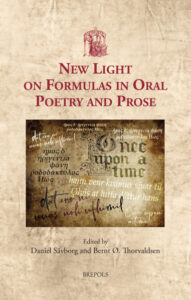
New Light on Formulas in Oral Poetry and Prose, ed. Daniel Sävborg and Bernt Ø. Thorvaldsen (Turnhout, 2023: USML 57), x+368 pp. ISBN 978-2-503-60428-2.
During the twentieth century scholars discovered that oral poetry in entirely unrelated cultures in the world share a basic characteristic: the use of verbal formulas, more or less fixed word strings, which were inherited from tradition. The discovery of formulas revolutionized the understanding of oral tradition, and how oral poetry was transmitted. Homer, Eddic poems, Karelian laments, Serbian heroic poetry, etc., were suddenly seen in a new light. But the original Oral-Formulaic Theory has also been questioned and revised. New approaches in the study of formulas have been developed among linguists and folklorists.
The present volume discusses new approaches, models, and interpretations of formulas in traditional poetry and prose. The twenty authors in the volume analyze formulas in a broad context by letting oral traditions from all over the world shed light on each other. The volume aims to deepen our understanding of the function and meaning of these formulas. A unique feature is that the volume focuses as much on formulas in oral prose as in poetry – usually formula studies have focused entirely or mainly on poetry.
Contents:
Daniel Sävborg and Bernt Ø. Thorvaldsen, “Formulas in Oral Poetry and Prose: An Introduction”
Frog, “Fee, Fi, Fo, Formula: Getting to Grips with the Concept and Deciding on a Definition”
Stephen A. Mitchell, “Formulas, Collocations, and Cultural Memory”
Slavica Rankovićand Miloš Ranković, “A Formula is a Habit Colliding with Life”
Chiara Bozzone, “Chunks, Collocations, and Constructions: The Homeric Formula in Cognitive and Linguistic Perspective”
Paul Acker, “A Further History of Orality and Eddic Poetry”
William Lamb, “Formulas in Scottish Traditional Narrative: Finding Poetry in the Prosaic”
Michael Schulte, “Towards a Typology of Runic Formulas: With a Focus on the One-Word Formula in the Older Runic Inscriptions”
Scott A. Mellor, “Revisiting Formula and Mythic Patterns and the Interplay Between The Poetic Edda and Vǫlsunga saga”
Daria Glebova, “Same Meaning, Different Words: Retelling as a Mode of Transmission in Old Norse-Icelandic Konungasögur Tradition”
Eugenia Kristina Vorobeva, “Depicting Violence in Íslendingasögur: A Formula on the Verge of Legal Tradition”
Inna Matyushina, “Formulaic Word-Play in the Poems of the Anglo-Saxon Chronicle”
Jonathan Roper, “Freeman’s Formulas: Openings, Transitions and Closes”
Tatiana Bogrdanova, “The Aesthetics of Russian Folktale Formulas: A View from Translation Studies”

